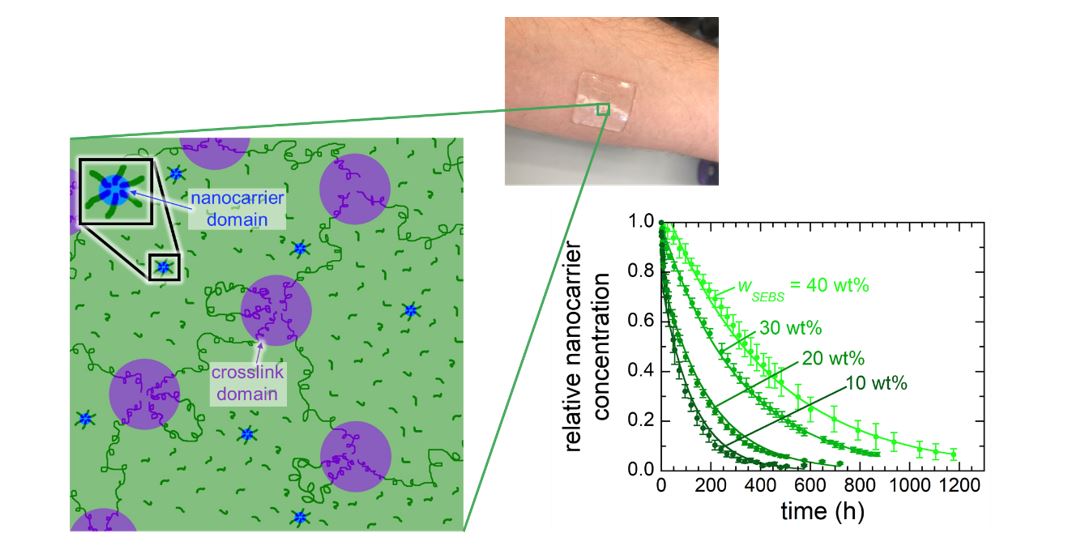Video Article Open Access
Recontextualizing TPEGs as Drug Delivery Media
Kenneth P. Mineart1,* , Lucas A. Rankin1, William W. Walker1, Byeongdu Lee2
1Department of Chemical Engineering, Bucknell University, Lewisburg, PA, 17837, USA
2X-Ray Science Division, Argonne National Laboratory, Lemont, IL, 60439, USA
Vid. Proc. Adv. Mater., Volume 2, Article ID 2105185 (2021)
DOI: 10.5185/vpoam.2021.05185
Publication Date (Web): 05 Aug 2021
Copyright © IAAM
Graphical Abstract

Abstract
Recently, thermoplastic elastomer gels (TPEGs) primarily composed of styrenic triblock copolymer and aliphatic gel solvent have been proposed as transdermal drug delivery media [1]. Transdermal delivery media require reasonable tack, mechanical stability, and the capacity to encapsulate desired drug molecules and meter their release. The inherent, well-established properties of TPEGs meet the first and second criteria, particularly when tackifier is incorporated. However, the encapsulation and release of payload molecules from TPEGs is underexplored. The goal of the present work is to establish formulation-structure-transport relationships in TPEGs. Formulation-structure behaviour is assessed using a combination of small angle x-ray scattering (SAXS) and theoretical calculation. Our results show that nanocarriers (i.e., reverse micelles) retain a spherical geometry (r ≈ 1 nm) across all formulations studied and over the course of transport experiments. Alternatively, varying triblock copolymer concentration is found to alter crosslink domain size, the distance between crosslinks, and the mesh size within gels’ continuous phase [2]. Nanocarrier release rate from gels is quantified using a newly-developed method based on Fourier-transform infrared spectroscopy (FTIR) [3] and is found to be sensitive to triblock copolymer concentration. Geometric analysis suggests that the change in mesh size within gels’ continuous phase is the most dominant factor in the observed release rate dependence on copolymer concentration. This theory is validated through studying nanocarrier release from gels varying in copolymer size, which allows the roles of crosslink size and spacing and continuous phase mesh size to be decoupled. Ultimately, these results help to establish the feasibility of TPEG-based transdermal drug delivery media and inform their future design.
Keywords
Self-assembly; thermoplastic elastomer; polymer gels; solute transport.
Acknowledgement
We want to thank the NSF Division of Materials Research (award no. 1904047), the NSF Division of Civil, Mechanical and Manufacturing Innovation (award no. 1828082), and Bucknell University for financial support. We also want to thank Sonneborn, LLC for providing mineral oil samples and Kraton Polymers, LLC for supplying styrenic copolymers. This work used resources at the Advanced Photon Source, a U.S. Department of Energy (DOE) Office of Science User Facility operated for the DOE Office of Science by Argonne National Laboratory under Contract No. DE-AC02-06CH11357.
References
- C. G. M. Gennari, G. M. G. Quaroni, C. Creton, P. Minghetti, F. Cilurzo, International Journal of Pharmaceutics, 2020, 575, 118975.
- K. P. Mineart, W. W. Walker, J. Mogollon-Santiana, I. A. Coates, C. Hong, B. Lee, Polymer 2021, 214, 123246.
- K. P. Mineart, W. W. Walker, J. Mogollon-Santiana, B. Lee, Journal of Polymer Science 2020, 58, 1707.
Biography
Kenneth P. Mineart is an Assistant Professor of Chemical Engineering at Bucknell University in Lewisburg, PA, USA. He received his Ph.D. in Chemical Engineering from North Carolina State University in 2016 under the guidance of Dr. Richard J. Spontak. Following graduation, Dr. Mineart was a National Research Council (USA) Postdoctoral Fellow in the Materials Science and Engineering Division at the National Institute for Standards and Technology (NIST). He joined the faculty at Bucknell University in the fall of 2017. His current research interests are in the areas of molecular self-assembly and structure-property relationships.
Video Proceedings of Advanced Materials

Upcoming Congress



